天文学导论L02_motion资料
- 格式:pdf
- 大小:848.47 KB
- 文档页数:7

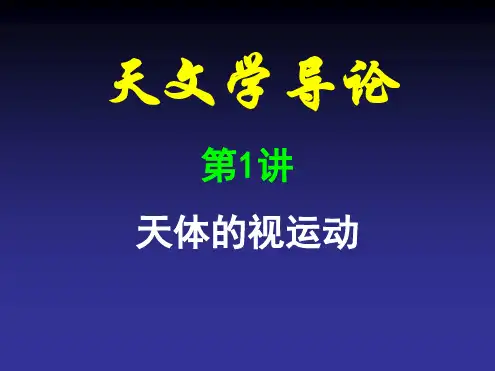


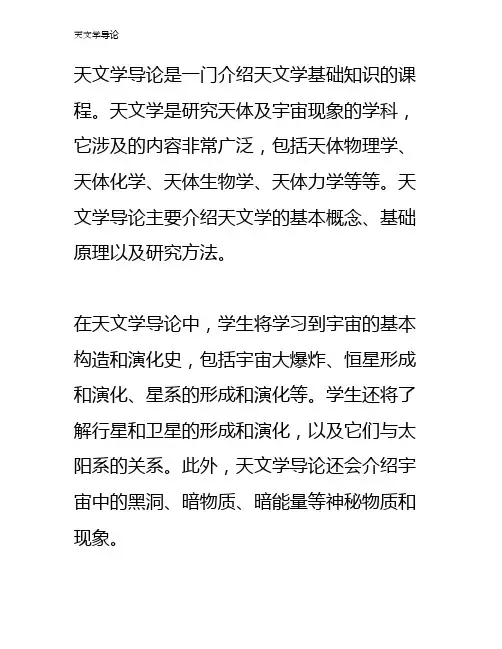
天文学导论是一门介绍天文学基础知识的课程。
天文学是研究天体及宇宙现象的学科,它涉及的内容非常广泛,包括天体物理学、天体化学、天体生物学、天体力学等等。
天文学导论主要介绍天文学的基本概念、基础原理以及研究方法。
在天文学导论中,学生将学习到宇宙的基本构造和演化史,包括宇宙大爆炸、恒星形成和演化、星系的形成和演化等。
学生还将了解行星和卫星的形成和演化,以及它们与太阳系的关系。
此外,天文学导论还会介绍宇宙中的黑洞、暗物质、暗能量等神秘物质和现象。
在天文学导论中,学生将学习到天文学的测
量方法,包括望远镜观测、天文摄影、光度
测量、频谱分析等等。
学生还将学习到天文
计算的基本方法,包括天体力学、宇宙学、
恒星演化和星系演化等等。
通过这些学习,
学生将能够理解天文学研究的基本方法和技术,为将来的天文研究打下坚实的基础。
在天文学导论中,学生还将学习到天文学的
历史和文化背景。
天文学是人类的一项重要
文化遗产,自古以来就受到人们的关注和尊重。
学生将了解到不同文化中对天文学的理
解和解释,包括古希腊、古埃及、中国、印
度等等。
通过了解天文学的历史和文化背景,学生将更深入地了解天文学的意义和价值。
总之,天文学导论是一门非常重要的课程,它将为学生打开探索宇宙的大门,帮助他们理解宇宙和地球的关系,提高他们的科学素养和思维能力。

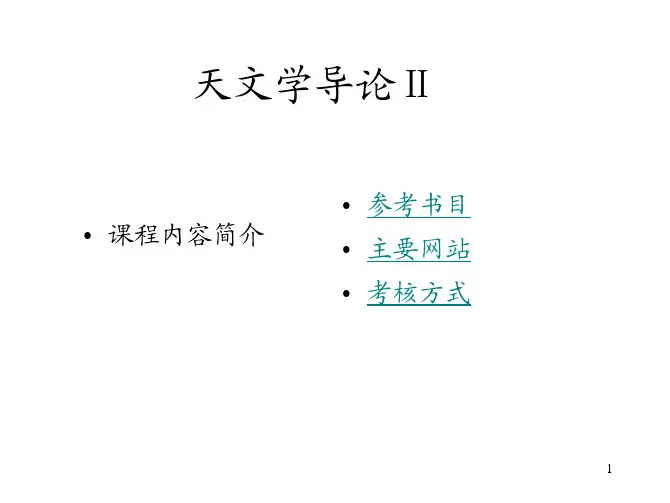
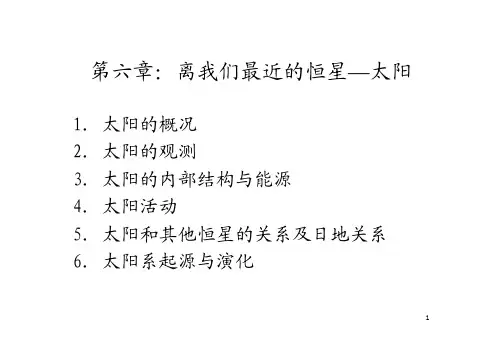
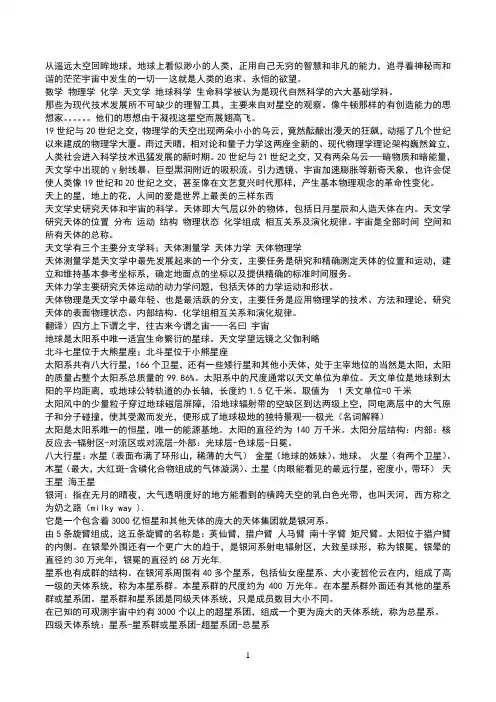
从遥远太空回眸地球,地球上看似渺小的人类,正用自己无穷的智慧和非凡的能力,追寻着神秘而和谐的茫茫宇宙中发生的一切---这就是人类的追求、永恒的欲望。
数学物理学化学天文学地球科学生命科学被认为是现代自然科学的六大基础学科。
那些为现代技术发展所不可缺少的理智工具,主要来自对星空的观察。
像牛顿那样的有创造能力的思想家。
他们的思想由于凝视这星空而展翅高飞。
19世纪与20世纪之交,物理学的天空出现两朵小小的乌云,竟然酝酿出漫天的狂飙,动摇了几个世纪以来建成的物理学大厦。
雨过天晴,相对论和量子力学这两座全新的、现代物理学理论架构巍然耸立,人类社会进入科学技术迅猛发展的新时期。
20世纪与21世纪之交,又有两朵乌云---暗物质和暗能量,天文学中出现的γ射线暴、巨型黑洞附近的吸积流、引力透镜、宇宙加速膨胀等新奇天象,也许会促使人类像19世纪和20世纪之交,甚至像在文艺复兴时代那样,产生基本物理观念的革命性变化。
天上的星,地上的花,人间的爱是世界上最美的三样东西天文学史研究天体和宇宙的科学。
天体即大气层以外的物体,包括日月星辰和人造天体在内。
天文学研究天体的位置分布运动结构物理状态化学组成相互关系及演化规律。
宇宙是全部时间空间和所有天体的总称。
天文学有三个主要分支学科;天体测量学天体力学天体物理学天体测量学是天文学中最先发展起来的一个分支,主要任务是研究和精确测定天体的位置和运动,建立和维持基本参考坐标系,确定地面点的坐标以及提供精确的标准时间服务。
天体力学主要研究天体运动的动力学问题,包括天体的力学运动和形状。
天体物理是天文学中最年轻、也是最活跃的分支,主要任务是应用物理学的技术、方法和理论,研究天体的表面物理状态、内部结构、化学组相互关系和演化规律。
翻译)四方上下谓之宇,往古来今谓之宙----名曰宇宙地球是太阳系中唯一适宜生命繁衍的星球。
天文学望远镜之父伽利略北斗七星位于大熊星座;北斗星位于小熊星座太阳系共有八大行星,166个卫星,还有一些矮行星和其他小天体,处于主宰地位的当然是太阳,太阳的质量占整个太阳系总质量的99.86%。
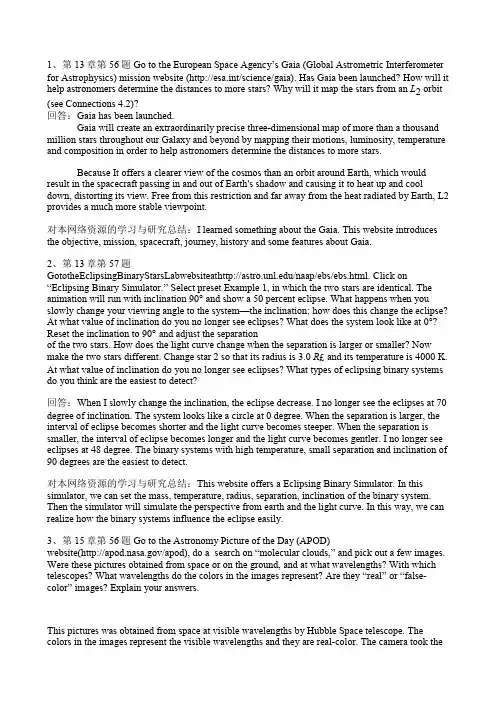
1、第13章第56題Go to the European Space Agency‟s Gaia (Global Astrometric Interferometer for Astrophysics) mission website (http://esa.int/science/gaia). Has Gaia been launched? How will it help astronomers determine the distances to more stars? Why will it map the stars from an L2 orbit (see Connections 4.2)?回答:Gaia has been launched.Gaia will create an extraordinarily precise three-dimensional map of more than a thousand million stars throughout our Galaxy and beyond by mapping their motions, luminosity, temperature and composition in order to help astronomers determine the distances to more stars.Because It offers a clearer view of the cosmos than an orbit around Earth, which would result in the spacecraft passing in and out of Earth's shadow and causing it to heat up and cool down, distorting its view. Free from this restriction and far away from the heat radiated by Earth, L2 provides a much more stable viewpoint.对本网络资源的学习与研究总结:I learned something about the Gaia. This website introduces the objective, mission, spacecraft, journey, history and some features about Gaia.2、第13章第57題GototheEclipsingBinaryStarsLabwebsiteat/naap/ebs/ebs.html. Click on “Eclipsing Binary Simulator.”Select preset Example 1, in which the two stars are identical. The animation will run with inclination 90°and show a 50 percent eclipse. What happens when you slowly change your viewing angle to the system—the inclination; how does this change the eclipse? At what value of inclination do you no longer see eclipses? What does the system look like at 0°? Reset the inclination to 90°and adjust the separationof the two stars. How does the light curve change when the separation is larger or smaller? Now make the two stars different. Change star 2 so that its radius is 3.0 R£and its temperature is 4000 K. At what value of inclination do you no longer see eclipses? What types of eclipsing binary systems do you think are the easiest to detect?回答:When I slowly change the inclination, the eclipse decrease. I no longer see the eclipses at 70 degree of inclination. The system looks like a circle at 0 degree. When the separation is larger, the interval of eclipse becomes shorter and the light curve becomes steeper. When the separation is smaller, the interval of eclipse becomes longer and the light curve becomes gentler. I no longer see eclipses at 48 degree. The binary systems with high temperature, small separation and inclination of 90 degrees are the easiest to detect.对本网络资源的学习与研究总结:This website offers a Eclipsing Binary Simulator. In this simulator, we can set the mass, temperature, radius, separation, inclination of the binary system. Then the simulator will simulate the perspective from earth and the light curve. In this way, we can realize how the binary systems influence the eclipse easily.3、第15章第56題Go to the Astronomy Picture of the Day (APOD)website(/apod), do a search on “molecular clouds,”and pick out a few images. Were these pictures obtained fromspace or on the ground, and at what wavelengths? With which telescopes? Whatwavelengths do the colors in the images represent? Are they “real”or “false-color”images? Explain your answers.This pictures was obtained from space at visible wavelengthsby Hubble Space telescope. The colors in the images represent the visible wavelengths and they are real-color. The camera took the photosof the molecular cloud in three basic colors and synthesis them into a real-color image, as is shown above.This pictures was obtained from space at inferred wavelengths by Hubble Space telescope. The colors in the images represent the inferred wavelengths and they are false-color.对本网络资源的学习与研究总结:This website provides lot of high-quality and brilliant images of universe and detailed information of each image. I learned how these pictures were taken.4、第15章第59題GotothewebsiteforStardust(), a Citizen Science project that asks Internet users to use a virtual microscope to analyze digital scans of particles collected by the Stardust mission in 2006. The goal is to identify tiny interstellardust grains. Follow the four steps under “Get Started”(you need to create a log-in account)and help search for stardust. Click on “News.”What has been learned from this project. Remember to savethe images for your homework, if required.回答:I chose the …foils‟to work on. What I have learned: When a hypervelocity particle hits the aluminum foil, a crater which is several times diameter of the particle is produced. People use electron microscopes instead of light microscopes to take photos of these foils. Although the particles stop quickly, many atoms of the particle remains and gives the information of the morphology and structure of the particle. In this stardust search, i have to find the craters in the images. Dark spots without bright rims are just holes in the foil and bright white spots without darkcenter are just surface contaminants. What I need to find are dark spots with bright rims.对本网络资源的学习与研究总结:This website asks volunteers from all over the world to find tiny particles by using two method ( aerogel and foils) in order to save the scientists and lab technicians‟time. I have to register fist. Then read a short tutorial to learn how to find the craters. And I must pass a test. Finally I can begin to find the craters among many images.五、觀星報告:在课程统一安排的观星活动中,我观测了木星和月球还有土星,是在天文台和路边天文分别观测了这些天体。
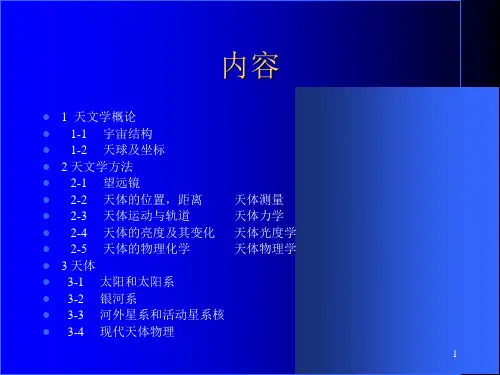
天文学史开普勒三定律(椭圆轨道、运行速度、轨道与周期)引力摄动:另一颗行星的引力导致某行星绕太阳的运动不符合两体假设非牛顿引力摄动:水星、金星近日点进动验证了爱因斯坦广义相对论钟慢效应:μ介子寿命为2.2×10-6s,以光速运动也仅能行进600m,而宇宙射线在大气外层产生的近光速μ介子却可以以到达地球表面。
引力透镜:由于质量对光的吸引,若被观测的星体与观测者连线上有大质量星系(透镜星系),观测者可能观察到多个像(爱因斯坦十字、双爱因斯坦环)天体视运动天体的周日视运动:由于地球自转导致的天体视运动太阳:东升西落,与当地正午通过天子午线达到最高点,两次通过子午线间的时间为一太阳日(24h)北京东经116.5度,东八区标准东经120度,北京时间正午12时时北京的太阳时为11点46分赤道参考系:把天空幻想为大球,北极指向北天极,南极指向南天极,赤道扩展为天赤道。
北天极对地面的高度等于北半球该地的纬度。
天赤道与天极的弧距离总是90度,与地平面相交于正东正西方向,且恰好看到一半。
天球自东向西旋转,每小时旋转15度,所有星体的视运动轨迹都平行于天赤道。
地平参考系:以正头顶为天顶,子午线从正南到正北穿过南天极、天顶和北天极平分天球。
本地参考系中天体位置在始终改变。
赤道上,一切星体都垂直于地平面升起和落下,所有星体都可见且在地平面上方12个小时周年视运动:天球坐标系上恒星的坐标固定,由于地球公转导致太阳在天球上向东运动。
这也导致了每天同一时间天空状况不同(因为太阳时制)太阳:太阳在天球上的位置始终自西向东移动,每年环绕天球一周,其在天球上的轨迹称为黄道。
太阳绕天球一周的时间是365.24天。
太阳日:24h,太阳连续两次到达子午线的时间。
恒星日:23h56min,恒星连续两次到达子午线的时间。
恒星日表明了地球自转的真实周期。
由于太阳一直向东运动,所以恒星比太阳运动的快一点。
由于我们使用太阳时,恒星每天升起、穿过子午线、下落的时间都要提前约4分钟,经过一个太阳年后回到原地。